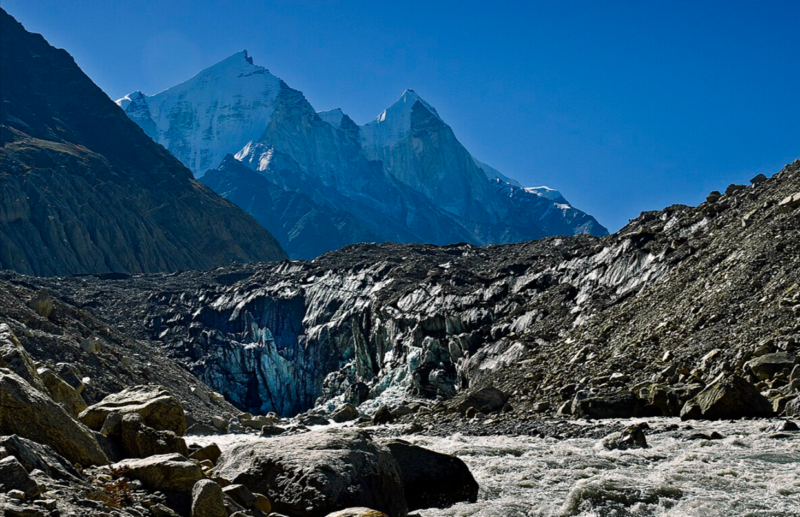Nestled deep within the rugged terrain of the Indian Himalayas lies one of the most significant glaciers in the world—Gangotri Glacier. Revered as the origin of the sacred Ganges River, the glacier is not only a geographical wonder but also a cultural and spiritual beacon for millions. Stretching across the Uttarkashi district of Uttarakhand, this glacial giant is both a lifeline and a warning signal—highlighting the importance of environmental conservation in the face of rapid climate change.
Geography and Physical Features
The Gangotri Glacier is one of the largest glaciers in the Himalayas, spanning roughly 30 kilometers in length and 2 to 4 kilometers in width. It is located in the Garhwal Himalayas, at an elevation ranging from about 4,100 meters (13,500 feet) at the snout, known as Gomukh, to more than 7,000 meters (23,000 feet) at its upper reaches near Chaukhamba, Shivling, and other high peaks.
This glacier feeds the Bhagirathi River, one of the primary headstreams of the Ganges River. As it flows down, the Bhagirathi merges with the Alaknanda River at Devprayag, where it officially becomes the Ganges or “Ganga,” the lifeblood of northern India.
Mythological and Cultural Significance
Gangotri Glacier holds immense spiritual importance in Hinduism. According to legend, the river Ganga descended from the heavens to Earth through the matted locks of Lord Shiva to cleanse the souls of King Bhagirath’s ancestors. This divine descent is believed to have occurred at Gomukh, the glacier’s snout.
Pilgrims from across the country make their way to the Gangotri Temple, located about 19 kilometers downstream from the glacier, in the town of Gangotri. The temple is dedicated to Goddess Ganga and is part of the Char Dham Yatra, one of the holiest pilgrimages in Hinduism.
The journey to Gomukh itself is considered an act of devotion. The 18-19 kilometer trek from Gangotri town is filled with natural beauty and spiritual ambiance, drawing not just pilgrims but also trekkers and nature enthusiasts.
Environmental Importance
The Gangotri Glacier plays a critical role in the hydrological cycle of the Indian subcontinent. It provides a sustained flow of freshwater to the Ganges River, which in turn supports the agricultural and domestic water needs of more than 400 million people.
Moreover, the glacier is a climate indicator. As one of the more studied Himalayan glaciers, it offers valuable data for researchers monitoring climate change. Variations in its mass, length, and meltwater discharge are considered key indicators of environmental shifts in the region.
Retreat and Climate Change
Despite its importance, the Gangotri Glacier is under significant threat. Over the past century, it has retreated by more than 1,500 meters, with an average annual retreat rate of about 15 to 20 meters in recent decades. This is largely attributed to global warming, deforestation, and increased human activity in the region.
The melting of the glacier not only threatens local ecosystems but also puts millions at risk downstream. Reduced glacial runoff can result in water shortages in the dry season, while rapid melting may cause glacial lake outburst floods (GLOFs), posing hazards to communities and infrastructure.
Scientific Studies and Monitoring
Numerous Indian and international institutions have been involved in monitoring the Gangotri Glacier. The Wadia Institute of Himalayan Geology, ISRO (Indian Space Research Organisation), and other organizations have employed remote sensing and field studies to observe its changes.
Data shows that the glacier’s volume and length are consistently decreasing. Studies also indicate that the glacier’s mass balance (the difference between accumulation and melting) is becoming increasingly negative—signaling that it is losing more ice than it is gaining.
Trekking and Eco-Tourism
Trekking to the Gangotri Glacier is a popular adventure, especially for those seeking both spiritual fulfillment and scenic beauty. The Gomukh-Tapovan Trek is particularly well-known, offering mesmerizing views of peaks like Mount Shivling, Bhagirathi I, II, and III, and Meru.
However, tourism in the area needs to be managed sustainably. Increased foot traffic and waste can degrade the fragile ecosystem. Several eco-conscious travel groups and government initiatives now promote leave-no-trace trekking and controlled access permits to help preserve the region.
Conservation Efforts
Recognizing the ecological fragility of the glacier, the Indian government and several NGOs have initiated conservation measures. These include:
-
Limiting the number of visitors to the Gomukh area each day.
-
Promoting environmentally friendly pilgrimage practices.
-
Conducting awareness campaigns for local communities and tourists.
-
Implementing afforestation programs to reduce soil erosion and stabilize the terrain.
Furthermore, there have been proposals to declare parts of the Gangotri region a National Park or Biosphere Reserve, offering higher levels of legal protection.
The Way Forward
The Gangotri Glacier stands at the intersection of nature, culture, and science. It is a sacred source, a freshwater reservoir, and a vital climate indicator all at once. Its retreat is not just a loss for India but a warning to the world.
Mitigating the impact of climate change on the Gangotri Glacier will require global cooperation, policy reforms, and public awareness. India’s climate strategy, including its participation in international environmental agreements and its push toward renewable energy, plays a significant role in this.
Conclusion
Gangotri Glacier is more than ice and rock—it is a symbol of life, faith, and ecological balance. As it silently recedes each year, it reminds us of our shared responsibility to protect the planet’s natural heritage. Whether as a pilgrim, a trekker, or a scientist, every person who visits this majestic glacier leaves with a deeper sense of wonder and responsibility. Protecting the Gangotri Glacier is not just about saving a natural wonder—it’s about securing the future of one of the most important river systems in the world.





